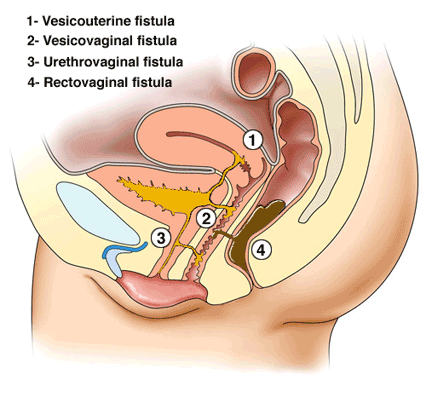

Obstetric Fistula is a debilitating condition that can occur in women as a complication of prolonged and obstructed childbirth ( vaginal delivery ). An Obstetric Fistula is basically an abnormal opening or passageway that forms between the vagina and nearby organ. It is a childbirth injury that has been largely neglected, despite the devastating impact it has on the affected women. It is commonly seen in poor young women, especially in the developing countries with underdeveloped medical facilities
Prevalence
The World Health Organization ( WHO ) defines Obstetric Fistula as an abnormal opening between a woman’s vagina and bladder and/or rectum through which her urine and/or feces leak continually. The overall prevalence is quite low. They are much more common in developing countries where women have less financial and geographical access to appropriate medical care. Quite understandably, they are extremely rare in developed nations, where sporadic cases may be found due to iatrogenic causes like radiation therapy or past surgery. The WHO estimates that more than 2 million women live with the condition and up to 100,000 new cases occur each year. A vast majority of these cases occur in the sub-Saharan Africa and South Asia

The most common cause of an Obstetric Fistula is a prolonged or obstructed labor. When the fetus does not fit through the mother’s pelvis, a forced vaginal delivery can cause extreme pressure leading to tissue damage. In the absence of availability of a Cesarean section, the result is usually a stillborn baby with damage to the tissues leading to uncontrollable passage of urine and feces into the vagina. The women most commonly at risk include very young women ( including girls subjected to child-marriage ) having their first child.
Other causes are:The abnormal passage formed between the vagina and the surrounding organ entails that the woman would continually leak urine and/or feces. This means she would be constantly wet and soiled and emit a foul odor, being shunned by husband and society. The woman may have to endure social isolation, economic deprivation and depression.
The diagnosis of obstetric fistula is done by physically examining the walls of the vagina. Vaginal infection is confirmed with blood and urine tests. An X-Ray or MRI may be needed to identify damaged tissue. Endoscopy is required to find out type and size of fistula.
The surgical closure of an Obstetric Fistula is the most effective way to treat this condition. Quality of life improves dramatically for the majority of women after successful fistula repair. Women are able to return to their normal lives; interact freely with their families and friends and lead a healthy married life.
About 80% to 90% of women with Vesico-vaginal Fistula can be cured by a simple vaginal surgery. The more complicated fistulas may require multiple attempts before continence is achieved.
As Healing Hands is a Proctology Clinic, we specialize in treating Recto-vaginal Fistulas. The Fistula is repaired in layers. Primary reconstruction is done. Sphincter repair is done. This is followed by vaginal wall repair. Finally, the rectal mucosa is repaired.
Prenatal care, with early identification of at-risk pregnancies and referral to tertiary centers for delivery is an important measure for prevention. Cesarean sections need to be more widely available as an option for the treatment of obstructed labor.
The patient is confined to bed rest for 2 weeks and she also abstains from intercourse for 3-4 months.
The complete recovery of tissue after surgery takes approximately 3 months.
No specific diet is required. Only healthy and fiber rich diet is recommended.
You may go home on the same day of surgery. In rare cases, one-night stay is required at the hospital. You must arrange someone to stay with you during the surgery and to drive you home afterward.